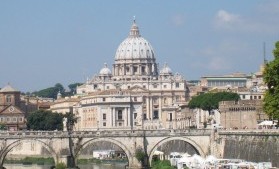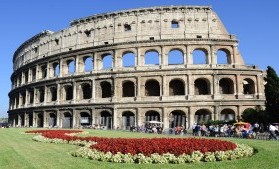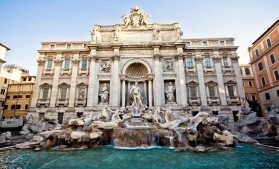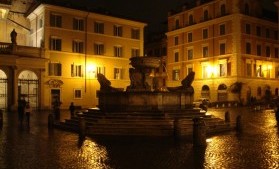Top 10 places to visit in Rome
Short time avalaible to visit Rome? Here follows an exciting itinerary for visitors with only a short time to discover the city’s main attractions.
 Saint Peter’s Basilica
Saint Peter’s Basilica
The majestic Basilica, still today one of the largest churches in the world, houses extraordinary works of art such as: the magnificent 29 meters high bronze baldachin by Bernini; Michelangelo’s Pieta,where many a visitor remains mesmerized by its combination of technical purity and emotional impact, the Funeral Monument of Clement XIII built by the great Venetian sculptor Antonio Canova ; and the beautiful mosaic of the spacecraft, built on a design by Giotto in 1305-1313. The dome dominating the skyline is the fruit of Michelangelo’s vision. Its amazing size and harmony is best appreciated by bravely climbing its steps. Rest assured, your efforts will be rewarded by the awe-inspiring panorama waiting for you at the top.
 Vatican Museums
Vatican Museums
Not so far from Saint Peter’s Basilica are located Vatican Museums where you can admire the papal apartments with Michelangelo and Raffaello’s paintings.
Museums include wonderful collections of works of art of the most prestigious in the world.
The visit takes at least half a day. To avoid the long queue at the entrance, we suggest you to allocate the whole afternoon to visit museums.
 Colosseum
Colosseum
The Colosseum is the symbol of Rome par excellence with a history stretching back almost two thousand years.
To the right of the Colosseum, here we are at the Arch of Constantine, Rome’s best-known triumphal arch. While just a stone’s through away we can see the Palatine Hill, where Romulus founded the Eternal City in 753 B.C.
 Roman Fora
Roman Fora
The Imperial Fora (Fori Imperiali in Italian) are a series of monumental fora (public squares), constructed in Rome over a period of one and a half centuries, between 46 BC and 113 AD. The forums were the center of the Roman Republic and of the Roman Empire.
Piazza Navona is one of the most beautiful and famous squares in Rome, where you can admire: the Fountain of the Four Rivers, designed by Gian Lorenzo Bernini; the Fountain of Neptune and Fountain Moro, works of Giacomo della Porta, the Church of St. Agnes in Agony and the Palazzo Pamphili.
 Pantheon
Pantheon
Pantheon, building in ancient Rome, built as a temple to all the gods, past, present and future is the Roman monument that has the largest number of records: it is the best preserved, it has the largest masonry dome in the history of architecture, it is considered the forerunner of all modern worship sites and the most copied and imitated ancient work
 Trevi Fountain
Trevi Fountain
Trevi Fountain is the largest and one of the most famous fountains of Rome; It is considered one of the most famous fountains in the world.
The monument, placed at the ending part of the Aqua Virgo, one of the oldest Roman aqueduct, has been sculptured against the backdrop of Palazzo Poli and depicts Triton taming Oceanus’ shell-shaped chariot drawn by sea horses. Before moving off, do not forget to throw a coin in the fountain.
Piazza di Spagna, at the bottom of the Spanish Steps<, is one of the most famous squares in Rome.
In the middle of the square is the famous Fontana della Barcaccia, sculpted by Bernini. The shape was chosen because, prior to the river walls being built, the Tiber often flooded and in 1598 there was a particularly bad flooding and the Piazza di Spagna was flooded up to a metre
In the nearby streets, such as Via Condotti, via Borgognona e via Frattina there are the most famous and expensive! top brands’ boutiques.
 Piazza Venezia;
Piazza Venezia;
In Piazza Venezia you can see il Vittoriano o Altare della Patria, a great monument, often hosting major exhibitions.
You can take the panoramic lifts to get to thetop of the monument where you can enjoy a breathtaking view. The view is all-embracing, taking in the majesty of the Colosseum, the splendour of the Imperial Forums, the magnificent churches of the historic centre, the River Tiber and Jewish Ghetto to sweep across to Capitol Hill and the Quirinale and even stretch as far as the district of EUR and the group of towns located south of Rome known as the Castelli Romani.
 Trastevere
Trastevere
Summer events on the Tiber contribute strongly to the untiring nocturnal movement of the Trastevere district.


